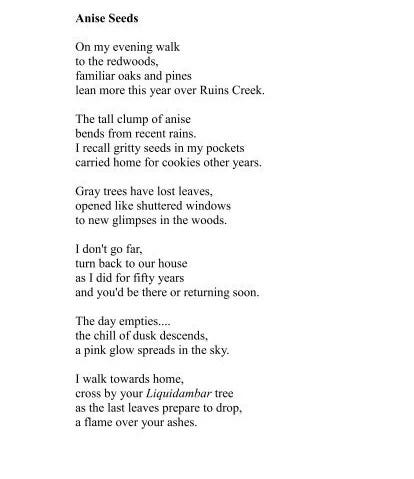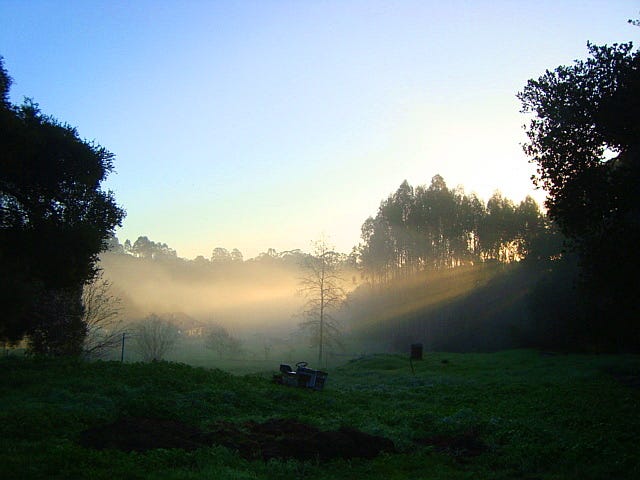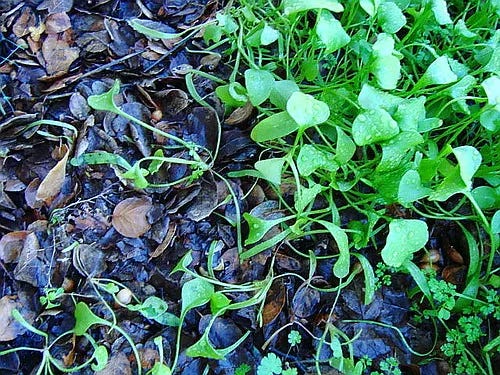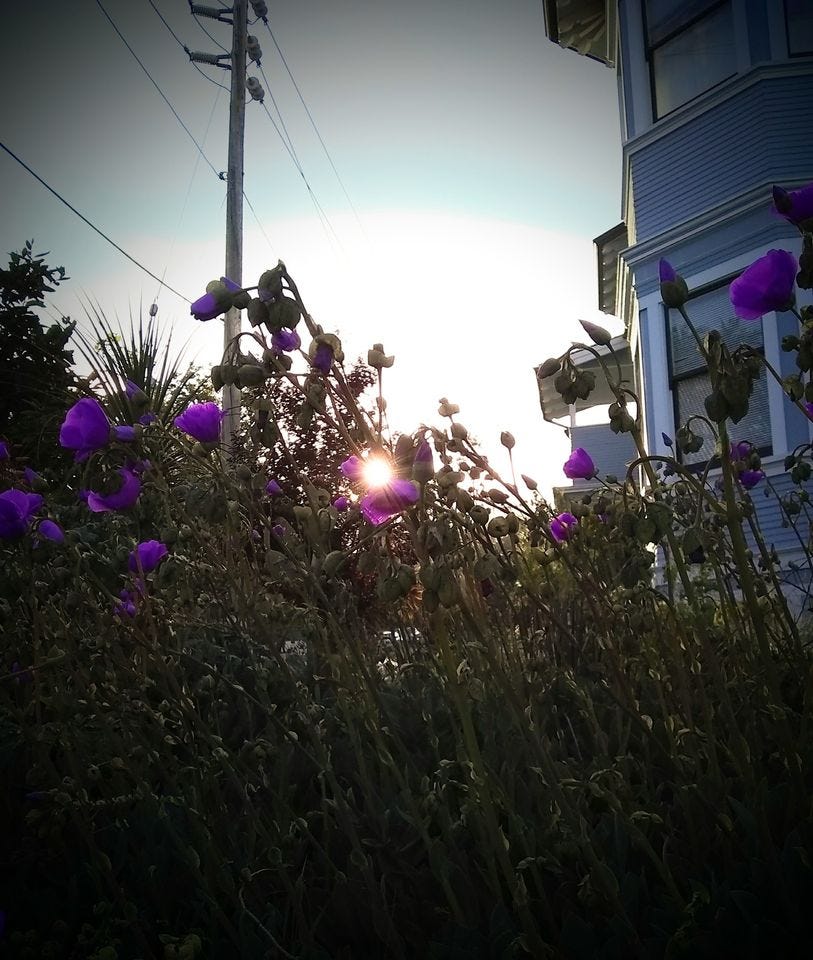What Grows Here
No. 124: Bernice Rendrick, What Grows Here, Lang Kambay Dulay, Raden Ayu Brongtodiningrat and Wiwin Fitriana, Sarah Lucas, Struthless, AZA, & Repair Together
HERE & NOW
A dear friend, poet Bernice F. Rendrick, has passed from this world, though not from our hearts. A poet of great perception and compassion, she was one of the people who got me involved with the writing community in Santa Cruz. I remember her kindness, her frustration with the political scene, her love of plants and rural gardening, and the many sunny afternoons and evenings in the dining room enjoying lovingly prepared meals, and drinking wine under the trees at her home with her family, friends, and writers.
This is the way I want
to be remembered--at rest
in a field scattered with poppies.
—Bernice Rendrick (last lines from her poem "April Poppies" from Santa Cruz Writes, Winter 2020).

Bernice Rendrick’s poetry page on Ariadne’s website. See also “Desert Storm Camp” in We Speak for Peace, Internet Archive.
WHAT GROWS HERE
I have a lot of fond memories of living in Elkhorn beside a large grassy field surrounded by ancient oak trees. But nostalgia can be tricky. I conveniently forget rental management issues, problems with neighbors, attack dogs, wasp nests, and skunks. Still—I do miss the sound of crickets and the occasional frog chorus. I miss being awakened by the calls of hawks and other raptors, and lulled to sleep by the calm hooting of barn owls.
One joy was learning about the local plant life and learning how to navigate neighborhood roads and even the field in the front of the house.
I wrote about it in “Poison Parsley,” Local Nomad 2013:
When my dog and I go for a walk in the big field near my home, I have to pay attention to the earth. This is because the ground of the field is quite uneven, damp in spots, and in the winter thickly covered with a carpet of grasses and weeds. It’s a good cognitive exercise; I constantly have to watch for holes, guessing how soft or hard the ground is under the green, and noting where certain types of vegetation prefer dry spots, while others (the pickleweed, for instance) gravitate to damp, mushy areas.
The soil at the south end is riddled with broken sea shells, a middens of some sort. Nearby, the remainders of tall weed stalks after mowing are dry, hard, and sharp-ended, sticking up vertically out of the ground. I wince, thinking of what would happen if I should trip out there and land on my hands. Near the middle of the field, there is a large, mysterious swatch where the grasses come up tall and straw-colored, as though some chemical underground is leaching out the color. The south end of the field is covered in emerald green clover, a surprisingly calming color to gaze upon.
Now that we’ve passed winter solstice, I look forward to foraging for New Zealand spinach, which is found in my “secret” cache near the ocean. Likewise, the burgeoning vegetation in the field prompts me to wonder what might be edible there. Early in winter, what looks like millions of tiny, dark-green lettuces emerge from the soil. There are also greens with feathery leaves that look like parsley or cilantro. Wouldn’t it be great to have a free parsley source? And there are broadleafed greens sprouting tiny yellow buds. I also see a few clumps of that stubborn cheeseweed (also known as Malva neglecta, and Bastardia viscosa sanctae crucis—or the “viscous bastards from Santa Cruz”) that infest my backyard every winter and is so hard to get rid of.
Now in mid-January, the “lettuces” [unidentified greens] still look like something that could be tossed in a salad, but some are sprouting tiny pink buds. So much for the “lettuce” theory. Wild radish? I pull a small one out of the ground. Yes, the white and pink root does look a bit radishy. I wonder if they are edible. The broad leafed weeds with the yellow buds are now knee-high, and they look a little like young broccoli (rabe).
While examining the feathery “parsleys,” I detect the warm, sweet scent of fennel—another plant that might be fun to harvest. I don’t see it, but I smell it. And that reminds me of something: fennel grows near poison hemlock. I look closely at the “parsley” stems, and notice that there are tiny purple spots on them. It’s hemlock!
I find a useful website, Calflora: What Grows Here. You can type in the county and zip code, and a page will come up listing all the flora growing in the area, along with photographs.
I was right about the wild radish and the hemlock, the latter also known as “poison parsley.” The “broccoli rabe” was in fact wild mustard. Since the field is usually overrun with hemlock during most of the year, I’m now loathe to try out the fennel, wild radish and mustard (all edible), fearing that they might absorb the poison in such close proximity.
So, although I’ve lived in Elkhorn for about two years now, perhaps I know the Central California area better than I think; I know the earth here—enough to be wary. How many fields have I walked through in my life? How many times have I followed a path near water, and noticed fennel growing near hemlock? As a child I squeezed the milky juice from wild radish pods. I didn’t know the names then. Now I do.
Check out this Foraging Database.
Now I live near downtown Monterey. Everywhere I look there are tidy little gardens edged with brick, stone or cement. I do appreciate the occasional unruly garden, though.
If I forage, it’s mostly for mushrooms—though most of the time, my partner forages (he’s very careful about identification). There are a lot of fungi to be found in this area around December/January. See, for example, links in the captions below.


RABBIT HOLE
Lang Kambay Dulay wants to pass on her weaving knowledge to the younger generations:
Two Indonesian Batik artists, Raden Ayu Brongtodiningrat and Wiwin Fitriana, discuss traditional and nontraditional forms:
Rebel in-your-face artist Sarah Lucas is “still kicking against the pricks” (UK Guardian). CW: may not be safe for work!
A history of fonts. Boring? You may be surprised. Struthless (Campbell Walker) promises you that it’s interesting:
SOUNDINGS
I first heard AZA at several garden parties in Santa Cruz, and it was great to hear them in that informal setting. The group travels back and forth between the United States and Morocco annually. AZA will perform North African and indigenous Tamazight music of Morocco on December 2nd in Seaside, CA at the International School of Monterey. In the video below, made during the early days of the pandemic, they perform “Oho,” a song about the uncertainty of the times. They performed individually in their homes and filmed themselves using their mobile phones:
Dashka, Vika, and Sasha are members of Repair Together. They combine the youthful energy of Kyiv’s techno rave scene with mutual aid reconstruction projects in some of the most bombed-out (“de-occupied”) areas of Ukraine while the damn war drags on:
Thanks for reading/listening to Eulipion Outpost. As always, special thanks to my supporters for donations to my Ko-fi!
I have a LinkTree now, so you can check out my other sites all in one location.
If you haven’t already, please subscribe:










I love the remembrance of your friend. Also the foraging stories and photos! As well, the weaver video you shared in the Rabbit Hole section was something I needed. Thank you!